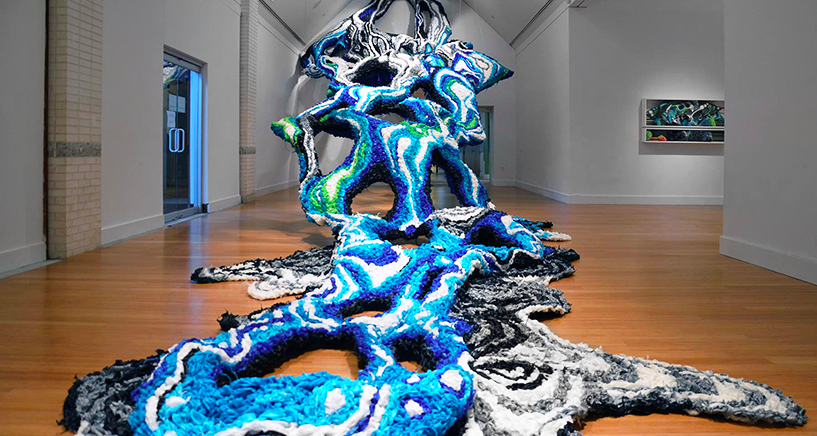American artist Crystal Wagner creates seemingly living sculptural pieces that sprawl through and around spaces. Her immersive works play with architecture and color to examine human beings’ relationship to their environment and to each other. We caught up with Crystal for an insight into her process.
How did your life as an artist begin?
I have been making art pretty obsessively since I was four or five. I have been incredibly prolific during the span of time from then to now; the work has evolved from drawings of fantastical imaginary birds, to what it is today – sprawling biomorphic exotic landscapes that re-conceptualize everyday materials.
I’m crazy passionate and pursued every opportunity as a kid, but there was something about the idea that people had the ability to make things, fabricate their own realities that fascinated me. Art is a tool for so many things. Communication, exploring, connecting with our bodies. So it was always obvious that I would pursue art as a career.
What lead you to create your enormous, sprawling installations?
I spent time as an undergraduate student focusing on ceramic sculpture and went to graduate school for printmaking. All of my work up until my second year in graduate school had a person in it. I was interested in sociology and naturally as my focus shifted from examining people and their relationship to one another to people and their relationship to the world, the work evolved as well. I needed it to be more immersive, engaging.
Installation work gave me the opportunity to deal with space as the substrate and the audience as not only an observer, but as a necessary aspect of the work. They are meant to be explored, walked through, under.
What materials do you typically use to create them?
Currently I am working on two bodies of work that each explore different ideas related to human beings and their disconnection from the natural world. My installation work re-contextualizes everyday materials like plastic table-cloth and chicken wire, by emulating massive, immersive landscapes and environments. The material is incredibly important.
Our current modern landscapes are synthetic, mass-produced and manufactured. The table-cloth is the quintessential disposable, one time use stand-in for the flimsy consumer culture that we surround ourselves with. This artifice permeates every aspect of our physical relationship as our fingers spend more time touching smooth surfaces, our peripheral experience is suffering from technological glaucoma, and our senses atrophy to the new world of device driven psychology and physiology.
Walk us through the process of creating one of your sculptures from idea to realization.
Creating an installation is an intense process. I work site-specifically, so with the exception of the colors, all decisions are made on location. There is no planning. I typically have around two weeks of 12 to 18-hour days to complete an installation. In the first 15 minutes on location, I figure out what I am going to do.
In this fifteen minute walk-through, I get a sense of what the architecture is doing, what the light in the space is doing, I watch people walk through the space, I look for any unique or specific characteristics of the space that I can work to emphasize or exaggerate with my piece.
After my walkthrough, I start working; rolling out the chicken wire and building the armature. This usually takes three days and is pretty physically demanding. After the armature is placed, I start working the material into the form to give it color. I equate it to painting. Every single hole in the chicken wire is filled.
What are some of the challenges that arise?
Working site-specifically in some ways in like a performance. There are people watching you the entire time. Every decision you make is revealed and no part of what you are going to through is hidden.
When I was working on my installation in Times Square, which was 117 ft, up two escalators and in the lobby of a building that was the work place of thousands of Viacom employees, I was on display.
Despite the fact that the company had a live feed camera on me which was being broadcast all over the world, I had to find a way to delegate and focus on the work.
I had to make choices about color through the fatigue while climbing up four stories of scaffolding with the weird blue/purple light from Times Square in the background.
What is the best advice you have ever received?
I had a professor in graduate school, Anita Jung, who during a conversation we were having about my monetary concerns with regards to the work, told me “money should never be a reason not to do something, figure it out”. A lot of what I do is problem solving. So this advice stuck to me.
Who inspires you?
I’m a bit of a dork. I am inspired by so many amazing people. Elon Musk; a visionary with audacity and conviction, author David Abrams who so eloquently in all of his writing shares his concern for the human/nature disconnect, any number of scientists on the leading edge of discovering new and fascinating things about life.
My world is a perpetual stream of Radiolab, The Partially Examined Life, and TED talks. People actively engaged in being curious about the world we live in.
See more of Crystal’s work at www.crystalwagner.com and at the Virginia Museum Of Contemporary Art through April 17th: www.virginiamoca.org/crystal-wagner-surface-tension









